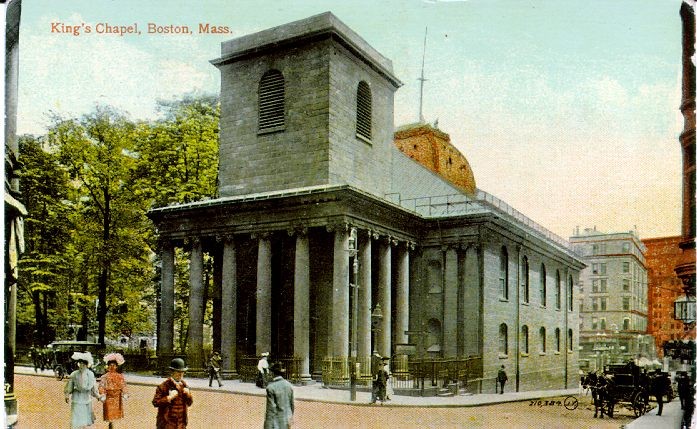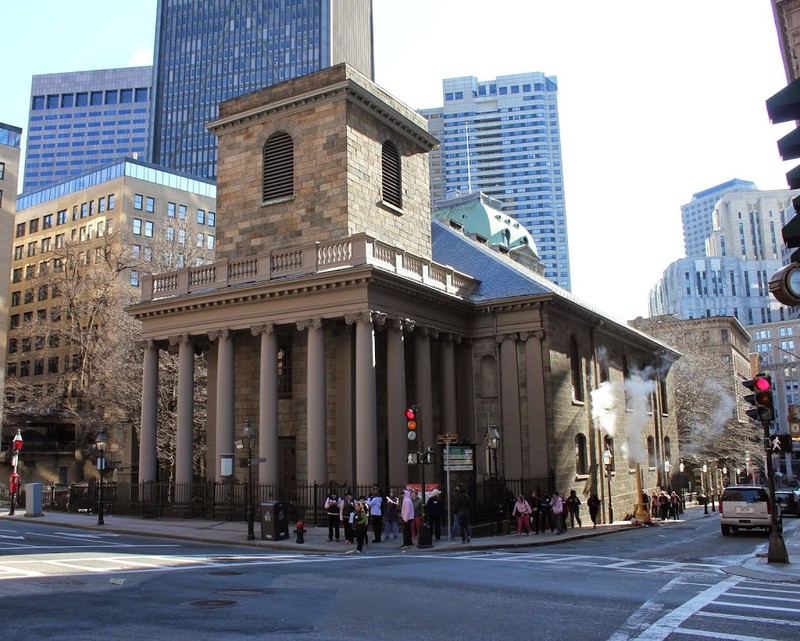King's Chapel
Introduction
Text-to-speech Audio
Images
Historic Postcard of Kings Chapel

Kings Chapel today

Kings Chapel interior, modern

Backstory and Context
Text-to-speech Audio
Established in 1686, King’s Chapel was the first Anglican congregation in New England. In a region famous for its Puritan beginnings, an Anglican, or Church of England, parish was a rarity; King’s Chapel was the first official non-Puritan church in Boston. Although the congregation was founded in 1686, they would not worship in a church building of their own until 1689. That first King’s Chapel was a small, wooden church occupying the same location as the current structure. The plot of land the church is built on had been part of Boston’s first English burial ground, which was established in 1630 the same year the city was founded. The smaller building fitted the needs of the congregation in the late-1600s, but by the mid-1700s it was far too small. A wealthy congregation in one of the richest cities in the thirteen colonies, the King’s Chapel community had the means to build a church on par with the elegance of Georgian London. Architect Peter Harrison was hired in 1749 and construction on a stone building soon began.
This larger church was completed in 1754 and was considered one of the most refined buildings in the American colonies. Harrison was heavily inspired by contemporary churches in London and the work of Italian Renaissance architect Andrea Palladio. As a stone structure, King’s Chapel would have stood out in the sea of wood and brick of colonial Boston. The interior was designed to be eye-catching as well; the colorful paint and intricate carvings were intended to display the congregation’s cosmopolitan style and prominence as the head Anglican church of the region.
The prosperity and growth of King’s Chapel in the mid-18th century would be halted by the Revolutionary War. Despite the modern conflation of the Church of England and Loyalist, the members of King’s Chapel (and Anglican congregations across the colonies) were politically divided. For those whose political sympathies or economic necessities aligned them with the Loyalist cause, life in Boston became dangerous. While the minister, the Reverend Henry Caner, and about a third of the congregation fled Boston during the Revolution, those who remained would go on to reimagine their church in a new country. Nearly six years after Rev. Caner left Boston, the congregation settled on a new man to lead their community. Hired as a lay reader in 1782, James Freeman would go on to become King’s Chapel’s first lay-ordained minister; a five-year journey in which Freeman and the church leadership would forge a path to become an independent parish and America’s first Christian Unitarian church.
An active congregation today, King’s Chapel holds services on Sunday mornings and Wednesday evenings. Celebrating a tradition that dates back to 1713, the church has a strong music program led by organist Heinrich Christiansen, hosting weekly noontime recitals on Tuesdays and formal evening concerts throughout the year.
Next to the church is the King’s Chapel Burial Ground, a historic graveyard that has been owned and operated by the city of Boston since 1630. Although its name seems to imply a connection to the church, the burial ground is civil space and has never been associated with the congregation; it follows a Puritan convention of naming places of burial for the nearest landmark (the Granary Burial Ground down the block follows the same naming custom). Like King’s Chapel, the King’s Chapel Burial Ground is open as a historic site on Boston’s Freedom Trail.
Sources
King's Chapel History Program. A Brief History. http://www.kings-chapel.org/briefhistorykc.html
King's Chapel. The Stone Chapel http://www.kings-chapel.org/stonechapel.html
Foote, Henry Wilder. The Annals of King's Chapel, Vol. 1. https://archive.org/details/annalsofkingsch01foot/page/n12/mode/2up.
Foote, Henry Wilder. The Annals of King's Chapel, Vol. 2. https://archive.org/details/annalsofkingsch02foot/page/n10/mode/2up.
